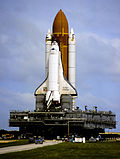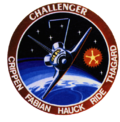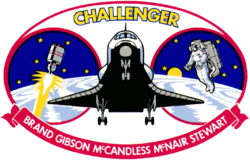Space Shuttle Challenger
Space Shuttle Challenger (OV-099) was the second space shuttle used by NASA to fly into outer space. The shuttle broke up 73 seconds after take-off from Cape Canaveral on 28 January 1986.[1] All seven astronauts who were on it at the time were killed. The crash happened because a rubber tube called an o-ring did not expand to fill a gap in one of the booster rockets, due to cold weather.
The Challenger was named after a Royal Navy ship that explored the Pacific and Atlantic Oceans from 1872 to 1876. Challenger was also the name of the Apollo 17 Lunar Excursion Module.
Crew
- Francis "Dick" Scobee (46)
- Michael John Smith (40)
- Judith Resnik (36)
- Ellison Onizuka (39)
- Ronald McNair (35)
- Gregory Jarvis (41)
- Christa McAuliffe (37), first teacher in space
Missions
| # | Date | Designation | Launch pad | Landing location | Notes |
|---|---|---|---|---|---|
| 1 | 04.April.1983 | STS-6 | 39-A | Edwards Air Force Base | First Shuttle Space Walk |
| 2 | .18.June.1983 | STS-7 | 39-A | Edwards Air Force Base | First U.S. Woman in Space |
| 3 | 30. August.1983 | STS-8 | 39-A | Edwards Air Force Base | First Night Launch and Landing |
| 4 | 03. February.1984 | STS-41-B | 39-A | Kennedy Space Center | First KSC Landing |
| 5 | 06.April.1984 | STS-41-C | 39-A | Edwards Air Force Base | First on-orbit spacecraft repair. |
| 6 | 05.October.84 | STS-41-G | 39-A | Kennedy Space Center | Earth Radiation Budget Satellite, Office of Space and Terrestrial Applications-3. |
| 7 | 29.April.1985 | STS-51-B | 39-A | Edwards Air Force Base | Spacelab-3 |
| 8 | 29. July.1985 | STS-51-F | 39-A | Edwards Air Force Base | Spacelab-2 |
| 9 | 30.October.1985 | STS-61-A | 39-A | Edwards Air Force Base | D-1 Spacelab Mission (First German Dedicated Spacelab) |
| 10 | 28 January 1986 | STS-51-L | 39-B | Did not land(Planned to land at Kennedy Space Center) | TDRS-2; SPARTAN-203 Satellites. Shuttle destroyed after liftoff & all seven astronauts on board died. |
Space Shuttle Challenger Media
Challenger being prepared in 1985 for its penultimate flight, STS-61-A
Challenger atop a Crawler-transporter, en route to the launch site for its final flight, STS-51-L
Challenger being transported by Shuttle Carrier Aircraft 905, shortly before being delivered in 1982
The patch features a helmet visor of an astronaut performing an extravehicular activity. In the visor are reflected the sun's rays, the Challenger and its remote manipulator system (RMS) deploying the long duration exposure facility (LDEF), the Earth and blue sky, and another astronaut working at the damaged Solar Maximum Satellite (SMS). The scene is encircled by the surnames of the crewmembers.
References
- ↑ "Space Today Online - Space Shuttle Stories". spacetoday.org. Retrieved 19 November 2010.









